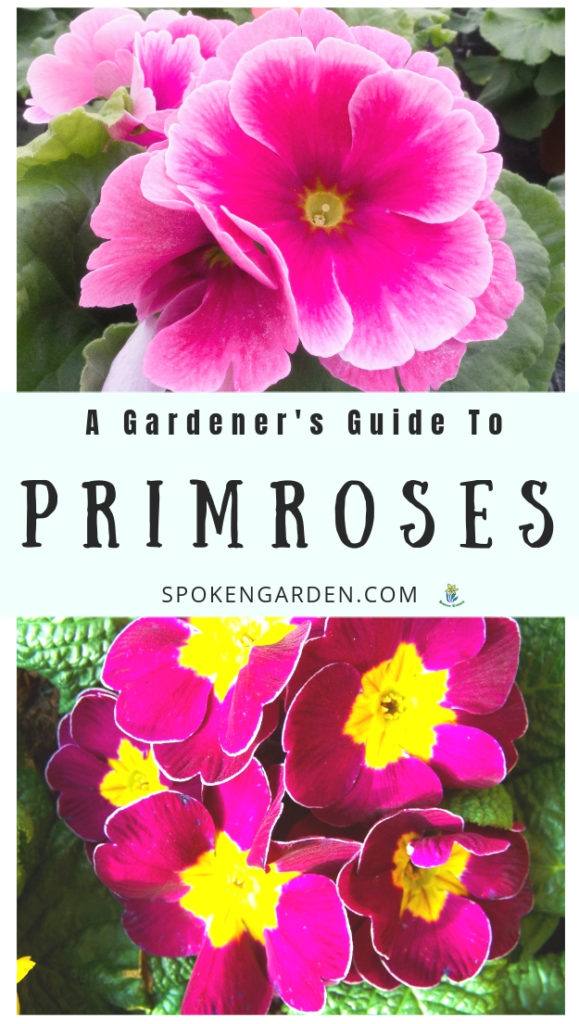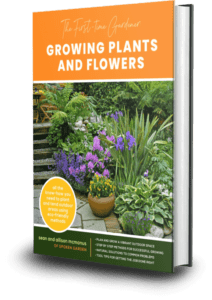
If you want a variety of color in your early spring blooming garden, look no further than primroses.
One of the first perennials to bloom, they dazzle with early Spring color.
And, being a very versatile plant, they can grow in many different cool and warm climates with relatively little maintenance. Start browsing for seeds here!
In our Primrose plant guide below, you’ll learn about Primroses and their basic plant care so you can enjoy them every Spring for years to come.
Primrose Quick Plant Facts
| Sun Exposure | In cool summer regions they can take full sun, but in warmer climates partial shade or a bright-type shade is needed. |
| Water Needs | Regular watering is needed for new or older plants. |
| Soil Needs | Need organically rich well-draining soil. |
| Cold-Hardiness Zones | USDA hardiness zones 4 to 8. |
| Bloom Time | Winter to early or mid-Spring. |
| Flower Colors | Red, Pink, Purple, Yellow, White, Orange. Also, they can be almost any specific color with different shades of one specific color and multicolored. |
| Mature Height/Width | 8-inches high and 1-foot wide. |
| Plant Spacing | Should be planted on 6-8 inch centers so they grow together relatively fast. Planted in groupings and will eventually spread. |
Become a Plant Profile Club member here, if you want more primrose plant care information than this!
[convertkit form=1655951]
Read our Primrose plant post below to learn:
A brief history and family information for Primroses
- Where to buy Primrose plants
- Fun facts, and so much more!
If you aren’t sure where to start learning about gardening, go to our Start Here page where you can get find beginning gardener topics by listening, watching, and reading.
If you aren’t sure where to start learning about gardening, go to our Start Here page where you can get find beginning gardener topics by listening, watching, and reading.
In a hurry? Pin it for later!!
Primroses: Why We’re Featuring This Plant
First, Primroses are known as a spring bloomer, but they can bloom anytime between late winter through summer season depending on the climate and species of plant.
The Primrose is an excellent plant for partly shaded landscapes around the world and for late winter and early spring flower interest.
In addition, they are great for woodland gardens, used as edging, or planted in containers. They look great with other partial to full sun plants like Daffodils, Azaleas, Mums, and more.
Plus, did you know their petals are edible?
Finally, we’re featuring the Primrose because of the vast variety of flower colors available including red, orange, pink, purple, yellow, white, and blue. Take your pick.
By the way, Primroses (Primula genus) and Evening Primroses (Oenothera genus) are two completely different plants from different plant families (Primulaceae and Onagraceae).
Read on to learn more!
You can find more of primrose care needs, when it flowers, its uses, and more by becoming a Plant Profile Club member.
(By the way, this post contains affiliate links. That means that if you click on any of the links we are promoting, we might get a small commission at no cost to you which helps us run our website and podcast).
Primrose Flowers: History and Uses
Primrose Family

These beautiful Primroses are Primulaceae family and related to
Primroses are in the Primulaceae family and the genus Primula. This family group, also called the Primrose family, includes herbaceous and woody flowering plants ranging between garden favorites and wildflowers.
With close to 2800 species, including oxlip, cowslip, and auricula, most are valued for their ornamental flowers.
Other members of the Primulaceae family include cyclamen, shooting star, and scarlet pimpernel.
Primrose History
The word “Primrose” originates from the Latin word primus meaning “first or early” most likely due to their early Spring season arrival.
Primroses originated in the Himalayas and also in the cooler regions of Southeast Asia and Europe. Many species have even adapted to alpine climates.
Primula vulgaris, or Common Primrose, is native to mainly northern and western Europe, Turkey, Armenia, and Algeria.
Research indicates that Primroses have been cultivated and hybridized for hundreds of years.
In Western Culture, they are a universal token of Spring and of the Easter Holiday.
Today, most Primroses are grown and used for ornamental purposes but many varieties can be used in cooking and wine-making.
If you want to read more about the history of primroses, this is a great resource.
Primrose Seeds vs. Primrose Plants
Is it better to plant Primrose seeds or store-bought plants?
Well, do you prefer to wait a bit or do you want instant gratification?
There are benefits to either way you choose to plant your Primroses, so it really just depends on your preference.

Primrose plants can be planted from seed or plants depending on your preference.
Benefits of Primrose Seeds
- Can be cheaper in cost
- Satisfying to nurture and watch grow
- Often more variety of species available from seed
- Take about 3 weeks to germinate
- Can order online and have shipped to your house
Benefits of Store-bought Primrose Plants
- Instantly gratifying
- Can plant in beds or containers and have instant color
- Easy to maintain
- Can hand-pick and choose your flower colors
- Can hand-pick and choose healthy plants
- Can opt to order online and have plants shipped to your house
Primrose Care
You can find more of primrose care needs, when it flowers, its uses, and more by becoming a Plant Profile Club member.
Primrose Perennials For Sale
Now it’s time to pick out your own Primroses for your garden!
The best part is there are so many beautiful colors, shapes, and sizes available.
Furthermore, we’ve gathered both Primrose seeds and Primrose live plants for you to choose from!

Or, do you need to shop for other garden plants for this spring?
Click here for the most up to date deals and plants on Amazon!
Primrose Plant Conclusion
Primroses signal the start of Spring season with their colorful blooms and variety of sizes.
A wonderful addition to any garden, Primrose plants are low maintenance and require very little yet reward with loads of color.
The petals are edible and can be enjoyed in a salad if you’re willing to be adventurous.
Whether you plant Primrose seeds or plant starts, they’ll dazzle your early spring garden for seasons to come.
Go on, pick your favorite color and reap the benefits!
You can find more of primrose care needs, when it flowers, its uses, and more by becoming a Plant Profile Club member.
Well, that’s all for now.
Thanks for reading and we hope you enjoyed our Primrose plant profile. Want to learn about other plants in your garden? Check out some of our previous plant profiles:
- The Gardener’s Guide to Dianthus
- The Gardener’s Guide to Chrysanthemums
- Hello Hellebore! January Plant Profile
- Roses: A Gardener’s Guide and Plant Profile
- Daffodils: A Gardener’s Guide and Plant Profile
If you aren’t sure where to start learning about gardening, go to our Start Here page where you can get find beginning gardener topics by listening, watching, and reading.
See you in the garden!
~ Sean and Allison
P.S. Find us on Pinterest, Twitter, Facebook, and Instagram so you don’t miss a thing!
References Used:
Spokengarden.com is a participant in the Amazon Services LLC Associates Program, an affiliate advertising program designed to provide a means for sites to earn advertising fees by advertising and linking to Amazon.com






